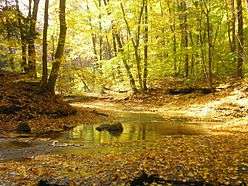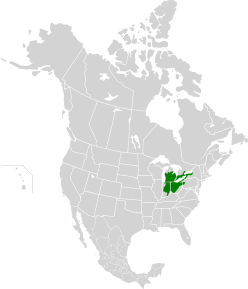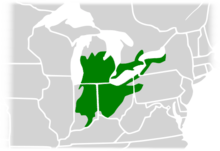Southern Great Lakes forests
The Southern Great Lakes lowland forests is a temperate broadleaf and mixed forest ecoregion of North America, as defined by the World Wildlife Fund. It lies mostly in the central northeastern United States and extends into southeast central Canada. In modern times, little of it remains intact due to land use, including agriculture and urban uses.
| Southern Great Lakes forests | |
|---|---|
 | |
 | |
| Ecology | |
| Realm | Nearctic |
| Biome | Temperate broadleaf and mixed forests |
| Borders | List
|
| Bird species | 220[1] |
| Mammal species | 56[1] |
| Geography | |
| Area | 244,500 km2 (94,400 sq mi) |
| Countries | United States and Canada |
| States/Provinces | Michigan, New York, Ohio, Ontario, Pennsylvania and Indiana |
| Conservation | |
| Habitat loss | 99%[1] |
Setting
This area includes the southern half of Michigan's Lower Peninsula, and much of Indiana and Ohio.[2] It also extends through the southern half of Southwest Ontario from Windsor to Toronto and into Pennsylvania and New York on the southern rims of lakes Erie and Ontario.
This region is characterized by warm-to-hot summers and mild-to-cold, snowy winters.
Flora
This ecoregion is associated with the temperate deciduous forest to the south and thus contained a variety of habitats including freshwater marshes, dunes, bogs, fens, and hardwood and conifer swamps.
Fauna
The Southern Great Lakes forests were very rich in wildlife. Birds include cardinals, downy woodpecker, wood duck and eastern screech owl. Large mammals including American black bear (Ursus americanus), moose (Alces alces), and gray wolf (Canis lupus) have been removed from this ecoregion and remaining mammals include white-tailed deer (Odocoileus virginianus), coyote (Canis latrans), snowshoe hare (Lepus americanus), eastern chipmunk (Tamias striatus), American red squirrel (Tamiasciurus hudsonicus) and eastern gray squirrel (Sciurus carolinensis).
Threats and preservation

Because of extensive urbanization and agricultural use very little of this habitat remains intact.
References and external links
- Hoekstra, J. M.; Molnar, J. L.; Jennings, M.; Revenga, C.; Spalding, M. D.; Boucher, T. M.; Robertson, J. C.; Heibel, T. J.; Ellison, K. (2010). Molnar, J. L. (ed.). The Atlas of Global Conservation: Changes, Challenges, and Opportunities to Make a Difference. University of California Press. ISBN 978-0-520-26256-0.
- "Southern Great Lakes forests". Terrestrial Ecoregions. World Wildlife Fund.
- "Southern Great Lakes Forests". Terrestrial Ecoregions. World Wildlife Fund.
- World Wildlife Fund, ed. (2001). "Southern Great Lakes forests". WildWorld Ecoregion Profile. National Geographic Society. Archived from the original on 2010-03-08.
- Central U.S. hardwood forests images at bioimages.vanderbilt.edu
- Southern Great Lakes forests